A Case Study of Change Management and Leadership at ANZ Bank
VerifiedAdded on 2023/06/12
|14
|3446
|201
Case Study
AI Summary
This case study examines the change management initiatives undertaken at ANZ Bank during McFarlane's tenure as CEO, focusing on the period around 1990 and beyond. It highlights the challenges faced by the bank, including poor organization, bad debts, customer dissatisfaction, and low employee morale. McFarlane implemented significant changes, such as cost-cutting measures, restructuring, and a focus on cultural transformation through performance management. The study identifies the difficulties in implementing these changes, particularly the impact on employee morale and trust. It also discusses the attributes of key leaders and the role of leadership in driving the transformation, emphasizing the importance of employee engagement and talent management. The case study concludes with recommendations for improving change management strategies and suggests that a focus on employee welfare and value-driven functions is essential for organizational success. Desklib offers a variety of solved assignments and past papers to aid students in their studies.
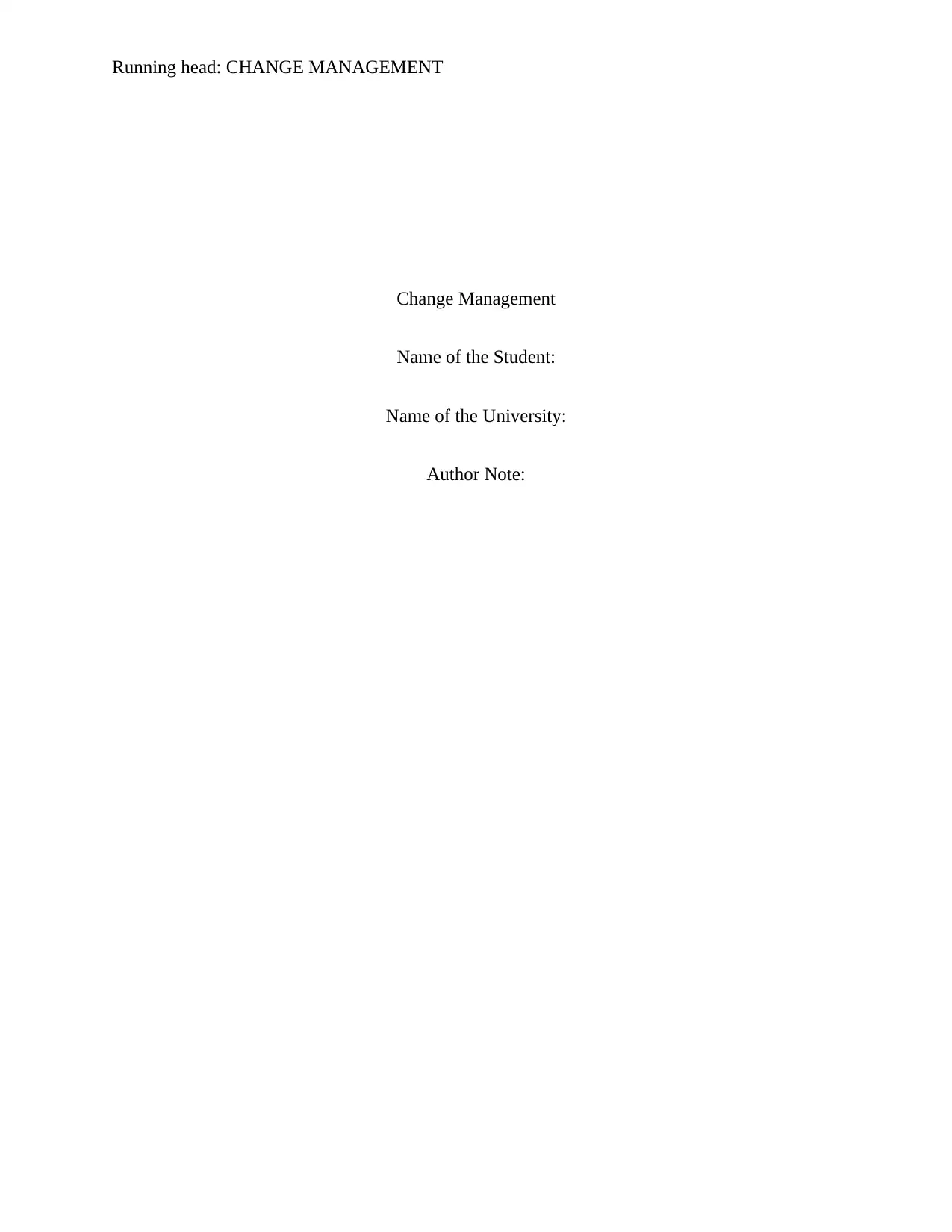
Running head: CHANGE MANAGEMENT
Change Management
Name of the Student:
Name of the University:
Author Note:
Change Management
Name of the Student:
Name of the University:
Author Note:
Paraphrase This Document
Need a fresh take? Get an instant paraphrase of this document with our AI Paraphraser
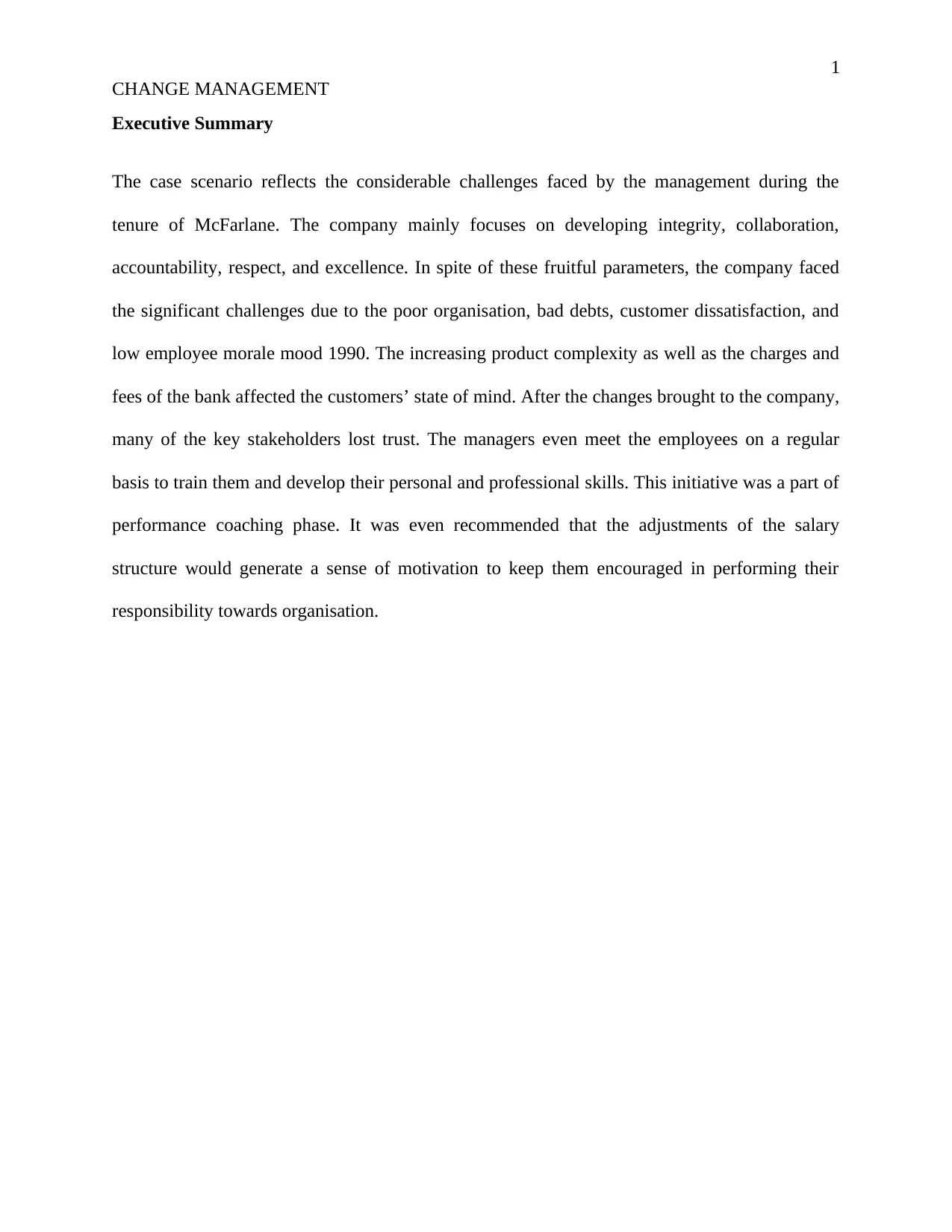
1
CHANGE MANAGEMENT
Executive Summary
The case scenario reflects the considerable challenges faced by the management during the
tenure of McFarlane. The company mainly focuses on developing integrity, collaboration,
accountability, respect, and excellence. In spite of these fruitful parameters, the company faced
the significant challenges due to the poor organisation, bad debts, customer dissatisfaction, and
low employee morale mood 1990. The increasing product complexity as well as the charges and
fees of the bank affected the customers’ state of mind. After the changes brought to the company,
many of the key stakeholders lost trust. The managers even meet the employees on a regular
basis to train them and develop their personal and professional skills. This initiative was a part of
performance coaching phase. It was even recommended that the adjustments of the salary
structure would generate a sense of motivation to keep them encouraged in performing their
responsibility towards organisation.
CHANGE MANAGEMENT
Executive Summary
The case scenario reflects the considerable challenges faced by the management during the
tenure of McFarlane. The company mainly focuses on developing integrity, collaboration,
accountability, respect, and excellence. In spite of these fruitful parameters, the company faced
the significant challenges due to the poor organisation, bad debts, customer dissatisfaction, and
low employee morale mood 1990. The increasing product complexity as well as the charges and
fees of the bank affected the customers’ state of mind. After the changes brought to the company,
many of the key stakeholders lost trust. The managers even meet the employees on a regular
basis to train them and develop their personal and professional skills. This initiative was a part of
performance coaching phase. It was even recommended that the adjustments of the salary
structure would generate a sense of motivation to keep them encouraged in performing their
responsibility towards organisation.
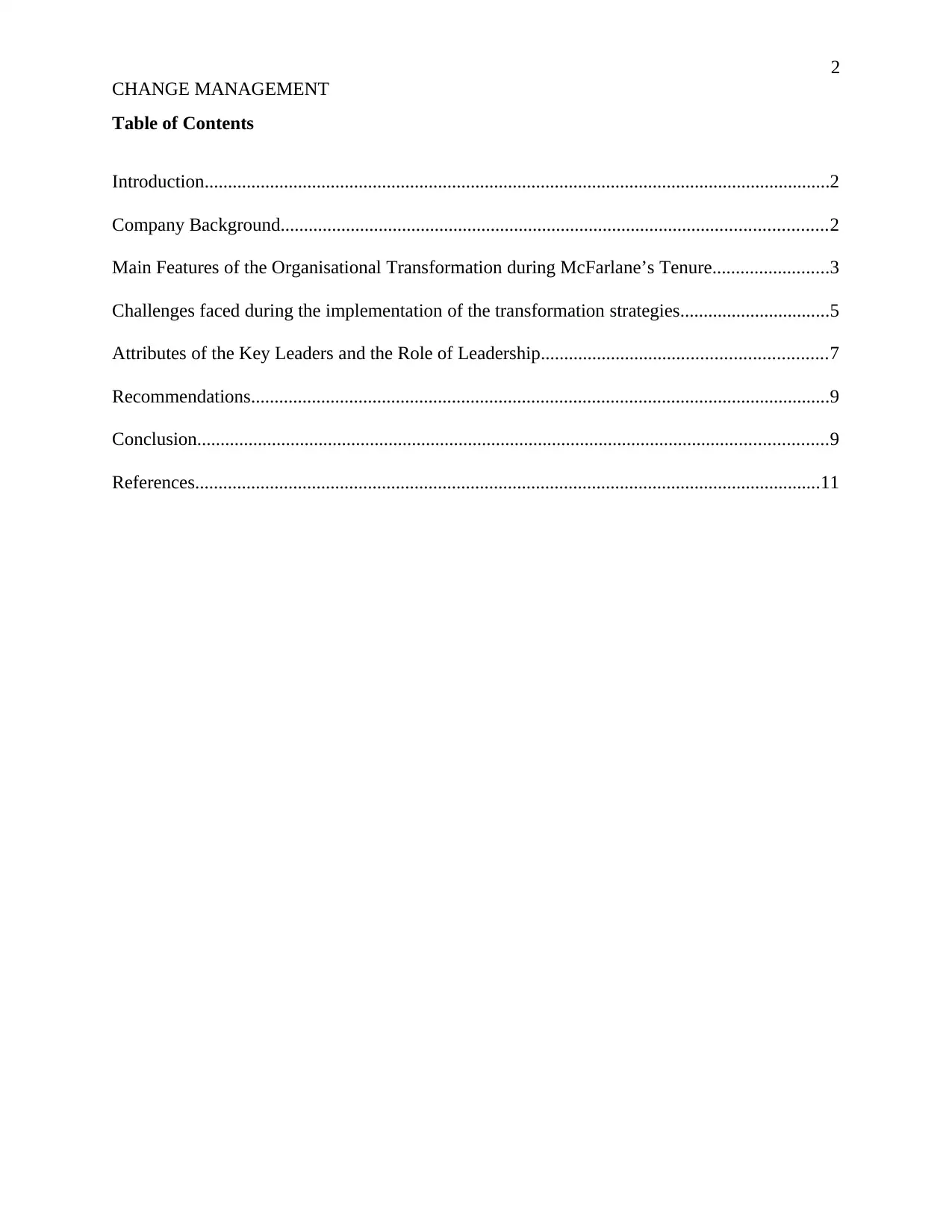
2
CHANGE MANAGEMENT
Table of Contents
Introduction......................................................................................................................................2
Company Background.....................................................................................................................2
Main Features of the Organisational Transformation during McFarlane’s Tenure.........................3
Challenges faced during the implementation of the transformation strategies................................5
Attributes of the Key Leaders and the Role of Leadership.............................................................7
Recommendations............................................................................................................................9
Conclusion.......................................................................................................................................9
References......................................................................................................................................11
CHANGE MANAGEMENT
Table of Contents
Introduction......................................................................................................................................2
Company Background.....................................................................................................................2
Main Features of the Organisational Transformation during McFarlane’s Tenure.........................3
Challenges faced during the implementation of the transformation strategies................................5
Attributes of the Key Leaders and the Role of Leadership.............................................................7
Recommendations............................................................................................................................9
Conclusion.......................................................................................................................................9
References......................................................................................................................................11
⊘ This is a preview!⊘
Do you want full access?
Subscribe today to unlock all pages.

Trusted by 1+ million students worldwide
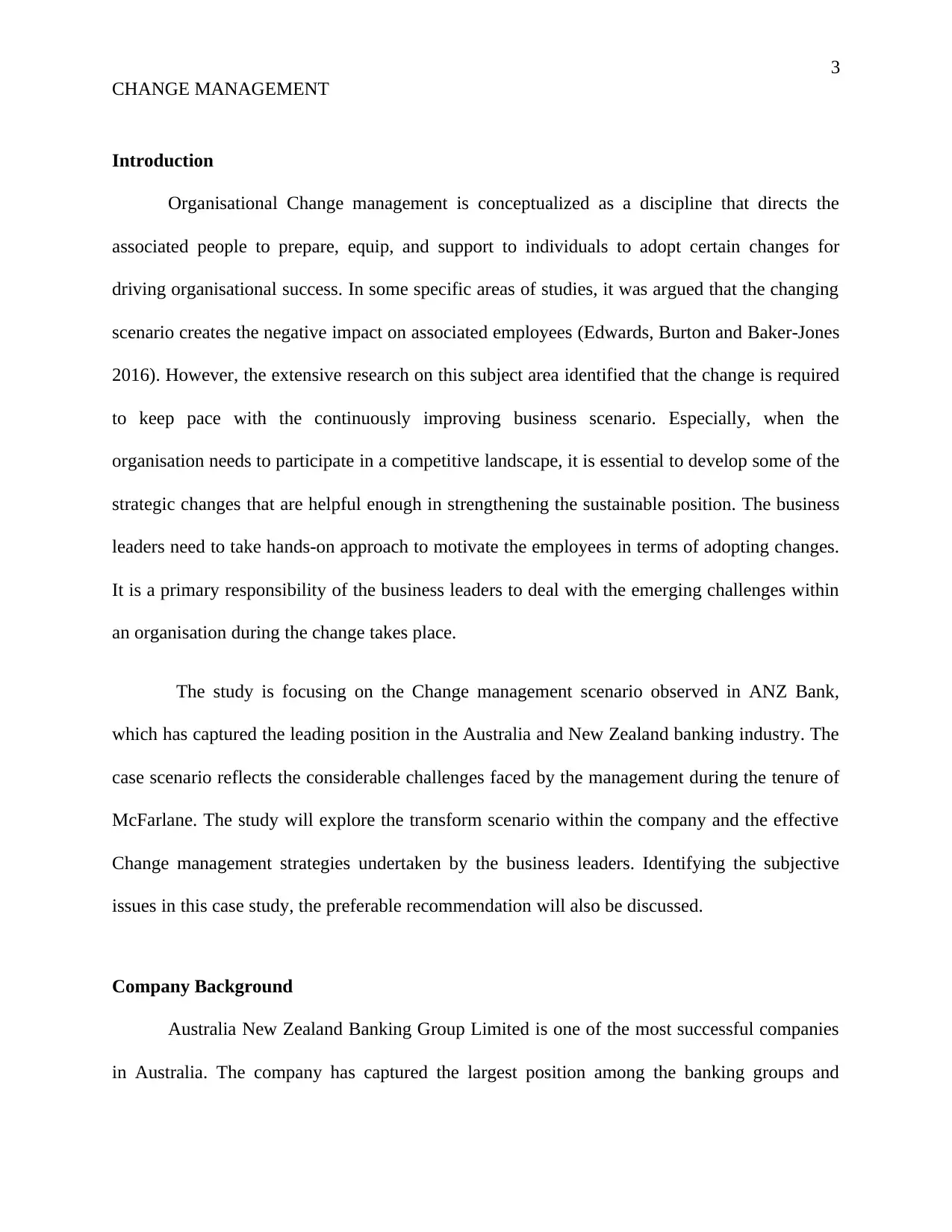
3
CHANGE MANAGEMENT
Introduction
Organisational Change management is conceptualized as a discipline that directs the
associated people to prepare, equip, and support to individuals to adopt certain changes for
driving organisational success. In some specific areas of studies, it was argued that the changing
scenario creates the negative impact on associated employees (Edwards, Burton and Baker-Jones
2016). However, the extensive research on this subject area identified that the change is required
to keep pace with the continuously improving business scenario. Especially, when the
organisation needs to participate in a competitive landscape, it is essential to develop some of the
strategic changes that are helpful enough in strengthening the sustainable position. The business
leaders need to take hands-on approach to motivate the employees in terms of adopting changes.
It is a primary responsibility of the business leaders to deal with the emerging challenges within
an organisation during the change takes place.
The study is focusing on the Change management scenario observed in ANZ Bank,
which has captured the leading position in the Australia and New Zealand banking industry. The
case scenario reflects the considerable challenges faced by the management during the tenure of
McFarlane. The study will explore the transform scenario within the company and the effective
Change management strategies undertaken by the business leaders. Identifying the subjective
issues in this case study, the preferable recommendation will also be discussed.
Company Background
Australia New Zealand Banking Group Limited is one of the most successful companies
in Australia. The company has captured the largest position among the banking groups and
CHANGE MANAGEMENT
Introduction
Organisational Change management is conceptualized as a discipline that directs the
associated people to prepare, equip, and support to individuals to adopt certain changes for
driving organisational success. In some specific areas of studies, it was argued that the changing
scenario creates the negative impact on associated employees (Edwards, Burton and Baker-Jones
2016). However, the extensive research on this subject area identified that the change is required
to keep pace with the continuously improving business scenario. Especially, when the
organisation needs to participate in a competitive landscape, it is essential to develop some of the
strategic changes that are helpful enough in strengthening the sustainable position. The business
leaders need to take hands-on approach to motivate the employees in terms of adopting changes.
It is a primary responsibility of the business leaders to deal with the emerging challenges within
an organisation during the change takes place.
The study is focusing on the Change management scenario observed in ANZ Bank,
which has captured the leading position in the Australia and New Zealand banking industry. The
case scenario reflects the considerable challenges faced by the management during the tenure of
McFarlane. The study will explore the transform scenario within the company and the effective
Change management strategies undertaken by the business leaders. Identifying the subjective
issues in this case study, the preferable recommendation will also be discussed.
Company Background
Australia New Zealand Banking Group Limited is one of the most successful companies
in Australia. The company has captured the largest position among the banking groups and
Paraphrase This Document
Need a fresh take? Get an instant paraphrase of this document with our AI Paraphraser
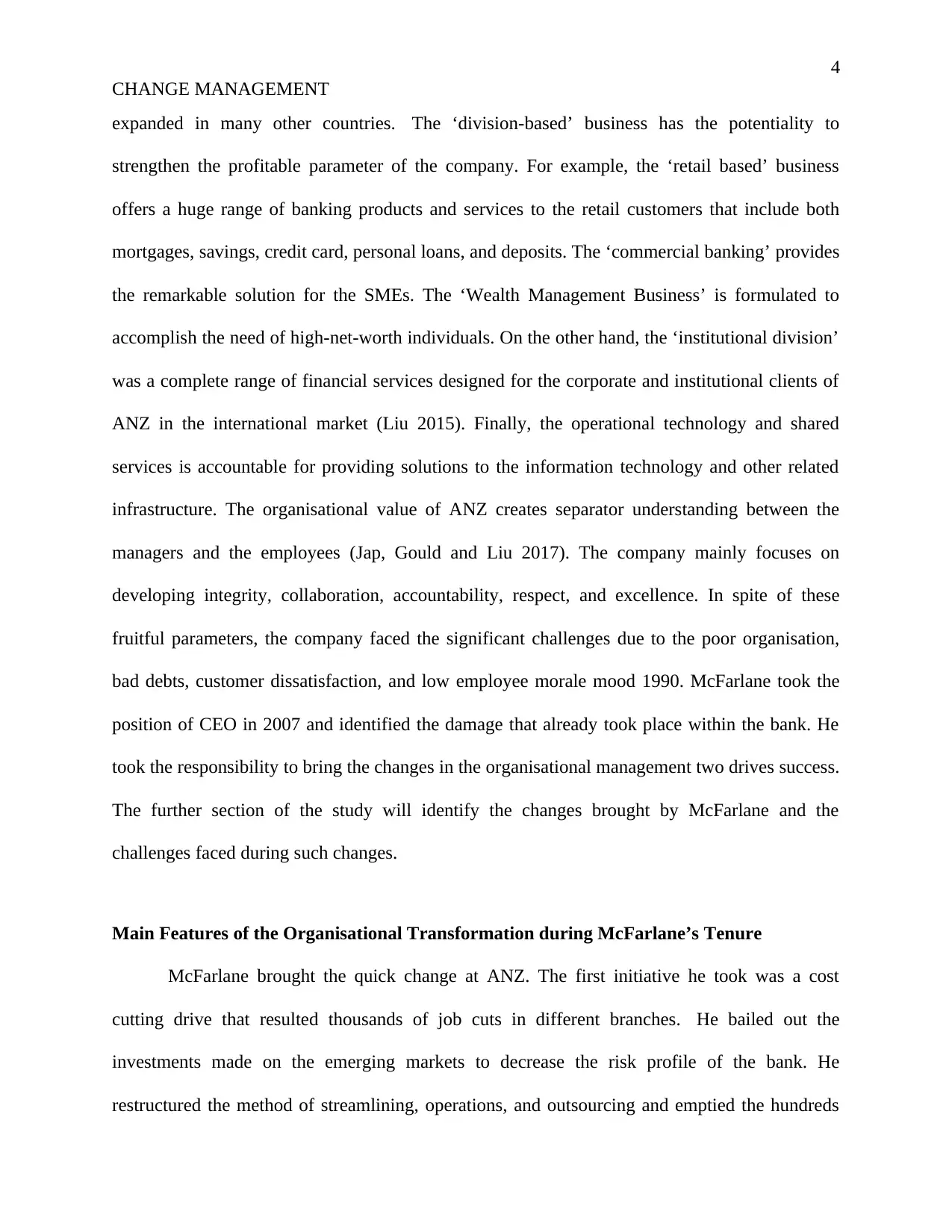
4
CHANGE MANAGEMENT
expanded in many other countries. The ‘division-based’ business has the potentiality to
strengthen the profitable parameter of the company. For example, the ‘retail based’ business
offers a huge range of banking products and services to the retail customers that include both
mortgages, savings, credit card, personal loans, and deposits. The ‘commercial banking’ provides
the remarkable solution for the SMEs. The ‘Wealth Management Business’ is formulated to
accomplish the need of high-net-worth individuals. On the other hand, the ‘institutional division’
was a complete range of financial services designed for the corporate and institutional clients of
ANZ in the international market (Liu 2015). Finally, the operational technology and shared
services is accountable for providing solutions to the information technology and other related
infrastructure. The organisational value of ANZ creates separator understanding between the
managers and the employees (Jap, Gould and Liu 2017). The company mainly focuses on
developing integrity, collaboration, accountability, respect, and excellence. In spite of these
fruitful parameters, the company faced the significant challenges due to the poor organisation,
bad debts, customer dissatisfaction, and low employee morale mood 1990. McFarlane took the
position of CEO in 2007 and identified the damage that already took place within the bank. He
took the responsibility to bring the changes in the organisational management two drives success.
The further section of the study will identify the changes brought by McFarlane and the
challenges faced during such changes.
Main Features of the Organisational Transformation during McFarlane’s Tenure
McFarlane brought the quick change at ANZ. The first initiative he took was a cost
cutting drive that resulted thousands of job cuts in different branches. He bailed out the
investments made on the emerging markets to decrease the risk profile of the bank. He
restructured the method of streamlining, operations, and outsourcing and emptied the hundreds
CHANGE MANAGEMENT
expanded in many other countries. The ‘division-based’ business has the potentiality to
strengthen the profitable parameter of the company. For example, the ‘retail based’ business
offers a huge range of banking products and services to the retail customers that include both
mortgages, savings, credit card, personal loans, and deposits. The ‘commercial banking’ provides
the remarkable solution for the SMEs. The ‘Wealth Management Business’ is formulated to
accomplish the need of high-net-worth individuals. On the other hand, the ‘institutional division’
was a complete range of financial services designed for the corporate and institutional clients of
ANZ in the international market (Liu 2015). Finally, the operational technology and shared
services is accountable for providing solutions to the information technology and other related
infrastructure. The organisational value of ANZ creates separator understanding between the
managers and the employees (Jap, Gould and Liu 2017). The company mainly focuses on
developing integrity, collaboration, accountability, respect, and excellence. In spite of these
fruitful parameters, the company faced the significant challenges due to the poor organisation,
bad debts, customer dissatisfaction, and low employee morale mood 1990. McFarlane took the
position of CEO in 2007 and identified the damage that already took place within the bank. He
took the responsibility to bring the changes in the organisational management two drives success.
The further section of the study will identify the changes brought by McFarlane and the
challenges faced during such changes.
Main Features of the Organisational Transformation during McFarlane’s Tenure
McFarlane brought the quick change at ANZ. The first initiative he took was a cost
cutting drive that resulted thousands of job cuts in different branches. He bailed out the
investments made on the emerging markets to decrease the risk profile of the bank. He
restructured the method of streamlining, operations, and outsourcing and emptied the hundreds
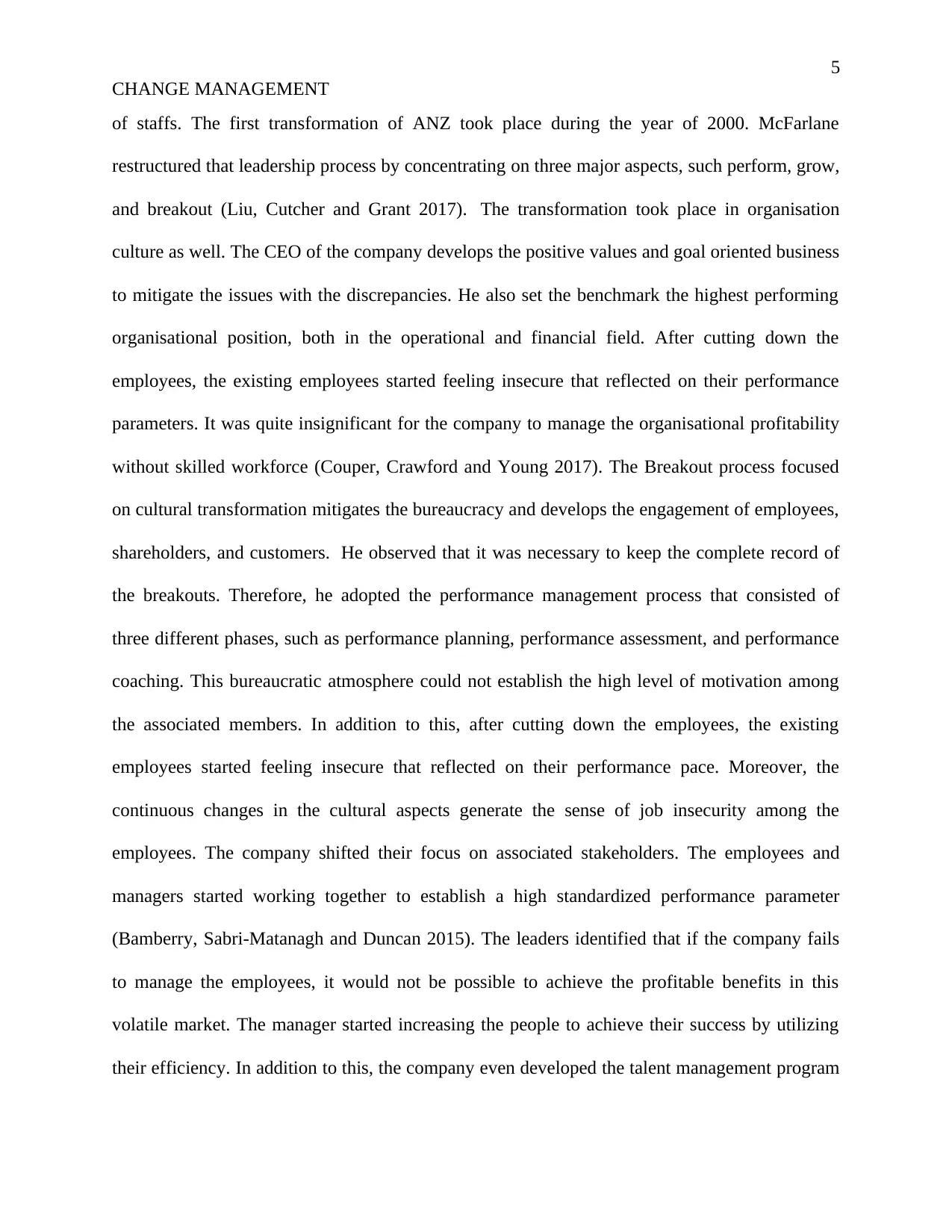
5
CHANGE MANAGEMENT
of staffs. The first transformation of ANZ took place during the year of 2000. McFarlane
restructured that leadership process by concentrating on three major aspects, such perform, grow,
and breakout (Liu, Cutcher and Grant 2017). The transformation took place in organisation
culture as well. The CEO of the company develops the positive values and goal oriented business
to mitigate the issues with the discrepancies. He also set the benchmark the highest performing
organisational position, both in the operational and financial field. After cutting down the
employees, the existing employees started feeling insecure that reflected on their performance
parameters. It was quite insignificant for the company to manage the organisational profitability
without skilled workforce (Couper, Crawford and Young 2017). The Breakout process focused
on cultural transformation mitigates the bureaucracy and develops the engagement of employees,
shareholders, and customers. He observed that it was necessary to keep the complete record of
the breakouts. Therefore, he adopted the performance management process that consisted of
three different phases, such as performance planning, performance assessment, and performance
coaching. This bureaucratic atmosphere could not establish the high level of motivation among
the associated members. In addition to this, after cutting down the employees, the existing
employees started feeling insecure that reflected on their performance pace. Moreover, the
continuous changes in the cultural aspects generate the sense of job insecurity among the
employees. The company shifted their focus on associated stakeholders. The employees and
managers started working together to establish a high standardized performance parameter
(Bamberry, Sabri-Matanagh and Duncan 2015). The leaders identified that if the company fails
to manage the employees, it would not be possible to achieve the profitable benefits in this
volatile market. The manager started increasing the people to achieve their success by utilizing
their efficiency. In addition to this, the company even developed the talent management program
CHANGE MANAGEMENT
of staffs. The first transformation of ANZ took place during the year of 2000. McFarlane
restructured that leadership process by concentrating on three major aspects, such perform, grow,
and breakout (Liu, Cutcher and Grant 2017). The transformation took place in organisation
culture as well. The CEO of the company develops the positive values and goal oriented business
to mitigate the issues with the discrepancies. He also set the benchmark the highest performing
organisational position, both in the operational and financial field. After cutting down the
employees, the existing employees started feeling insecure that reflected on their performance
parameters. It was quite insignificant for the company to manage the organisational profitability
without skilled workforce (Couper, Crawford and Young 2017). The Breakout process focused
on cultural transformation mitigates the bureaucracy and develops the engagement of employees,
shareholders, and customers. He observed that it was necessary to keep the complete record of
the breakouts. Therefore, he adopted the performance management process that consisted of
three different phases, such as performance planning, performance assessment, and performance
coaching. This bureaucratic atmosphere could not establish the high level of motivation among
the associated members. In addition to this, after cutting down the employees, the existing
employees started feeling insecure that reflected on their performance pace. Moreover, the
continuous changes in the cultural aspects generate the sense of job insecurity among the
employees. The company shifted their focus on associated stakeholders. The employees and
managers started working together to establish a high standardized performance parameter
(Bamberry, Sabri-Matanagh and Duncan 2015). The leaders identified that if the company fails
to manage the employees, it would not be possible to achieve the profitable benefits in this
volatile market. The manager started increasing the people to achieve their success by utilizing
their efficiency. In addition to this, the company even developed the talent management program
⊘ This is a preview!⊘
Do you want full access?
Subscribe today to unlock all pages.

Trusted by 1+ million students worldwide
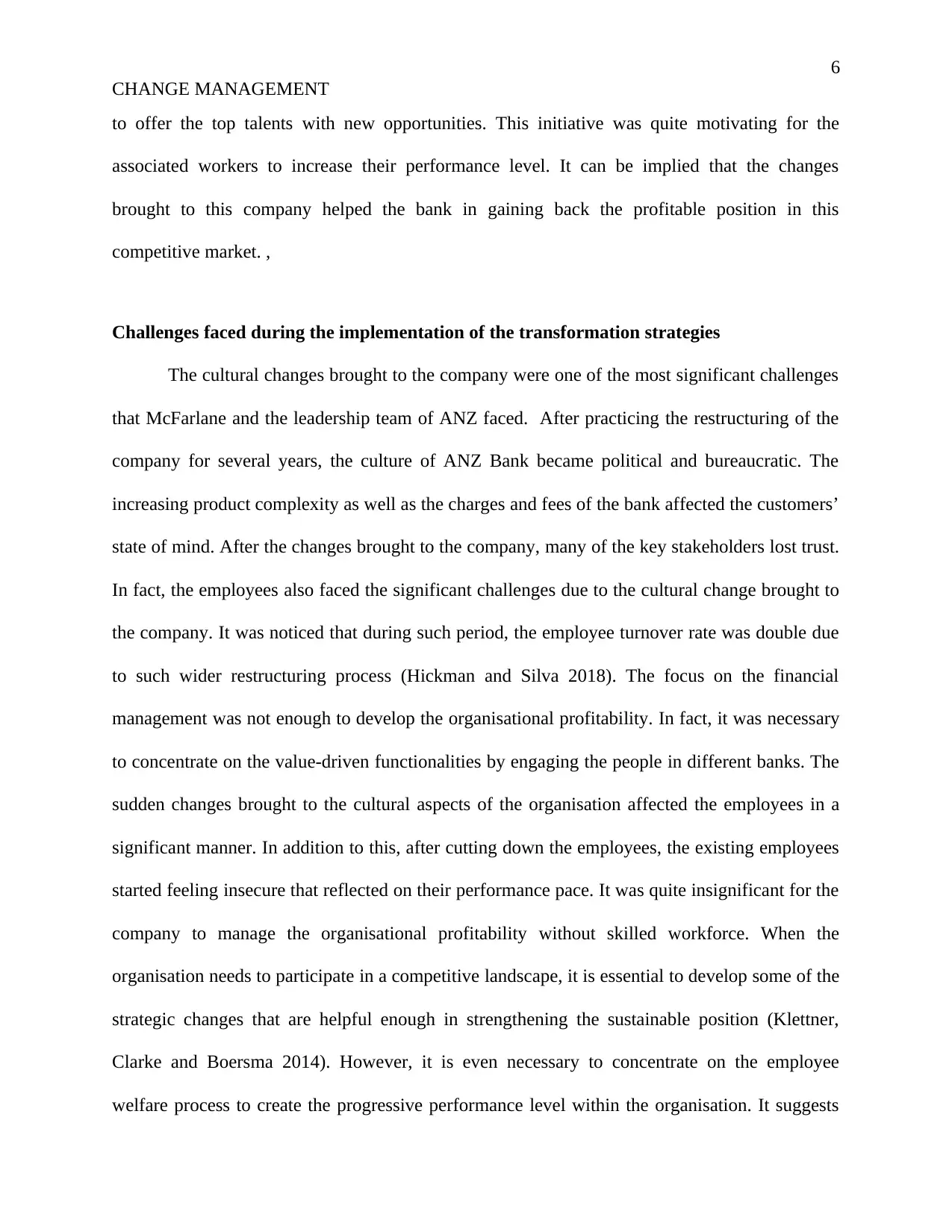
6
CHANGE MANAGEMENT
to offer the top talents with new opportunities. This initiative was quite motivating for the
associated workers to increase their performance level. It can be implied that the changes
brought to this company helped the bank in gaining back the profitable position in this
competitive market. ,
Challenges faced during the implementation of the transformation strategies
The cultural changes brought to the company were one of the most significant challenges
that McFarlane and the leadership team of ANZ faced. After practicing the restructuring of the
company for several years, the culture of ANZ Bank became political and bureaucratic. The
increasing product complexity as well as the charges and fees of the bank affected the customers’
state of mind. After the changes brought to the company, many of the key stakeholders lost trust.
In fact, the employees also faced the significant challenges due to the cultural change brought to
the company. It was noticed that during such period, the employee turnover rate was double due
to such wider restructuring process (Hickman and Silva 2018). The focus on the financial
management was not enough to develop the organisational profitability. In fact, it was necessary
to concentrate on the value-driven functionalities by engaging the people in different banks. The
sudden changes brought to the cultural aspects of the organisation affected the employees in a
significant manner. In addition to this, after cutting down the employees, the existing employees
started feeling insecure that reflected on their performance pace. It was quite insignificant for the
company to manage the organisational profitability without skilled workforce. When the
organisation needs to participate in a competitive landscape, it is essential to develop some of the
strategic changes that are helpful enough in strengthening the sustainable position (Klettner,
Clarke and Boersma 2014). However, it is even necessary to concentrate on the employee
welfare process to create the progressive performance level within the organisation. It suggests
CHANGE MANAGEMENT
to offer the top talents with new opportunities. This initiative was quite motivating for the
associated workers to increase their performance level. It can be implied that the changes
brought to this company helped the bank in gaining back the profitable position in this
competitive market. ,
Challenges faced during the implementation of the transformation strategies
The cultural changes brought to the company were one of the most significant challenges
that McFarlane and the leadership team of ANZ faced. After practicing the restructuring of the
company for several years, the culture of ANZ Bank became political and bureaucratic. The
increasing product complexity as well as the charges and fees of the bank affected the customers’
state of mind. After the changes brought to the company, many of the key stakeholders lost trust.
In fact, the employees also faced the significant challenges due to the cultural change brought to
the company. It was noticed that during such period, the employee turnover rate was double due
to such wider restructuring process (Hickman and Silva 2018). The focus on the financial
management was not enough to develop the organisational profitability. In fact, it was necessary
to concentrate on the value-driven functionalities by engaging the people in different banks. The
sudden changes brought to the cultural aspects of the organisation affected the employees in a
significant manner. In addition to this, after cutting down the employees, the existing employees
started feeling insecure that reflected on their performance pace. It was quite insignificant for the
company to manage the organisational profitability without skilled workforce. When the
organisation needs to participate in a competitive landscape, it is essential to develop some of the
strategic changes that are helpful enough in strengthening the sustainable position (Klettner,
Clarke and Boersma 2014). However, it is even necessary to concentrate on the employee
welfare process to create the progressive performance level within the organisation. It suggests
Paraphrase This Document
Need a fresh take? Get an instant paraphrase of this document with our AI Paraphraser
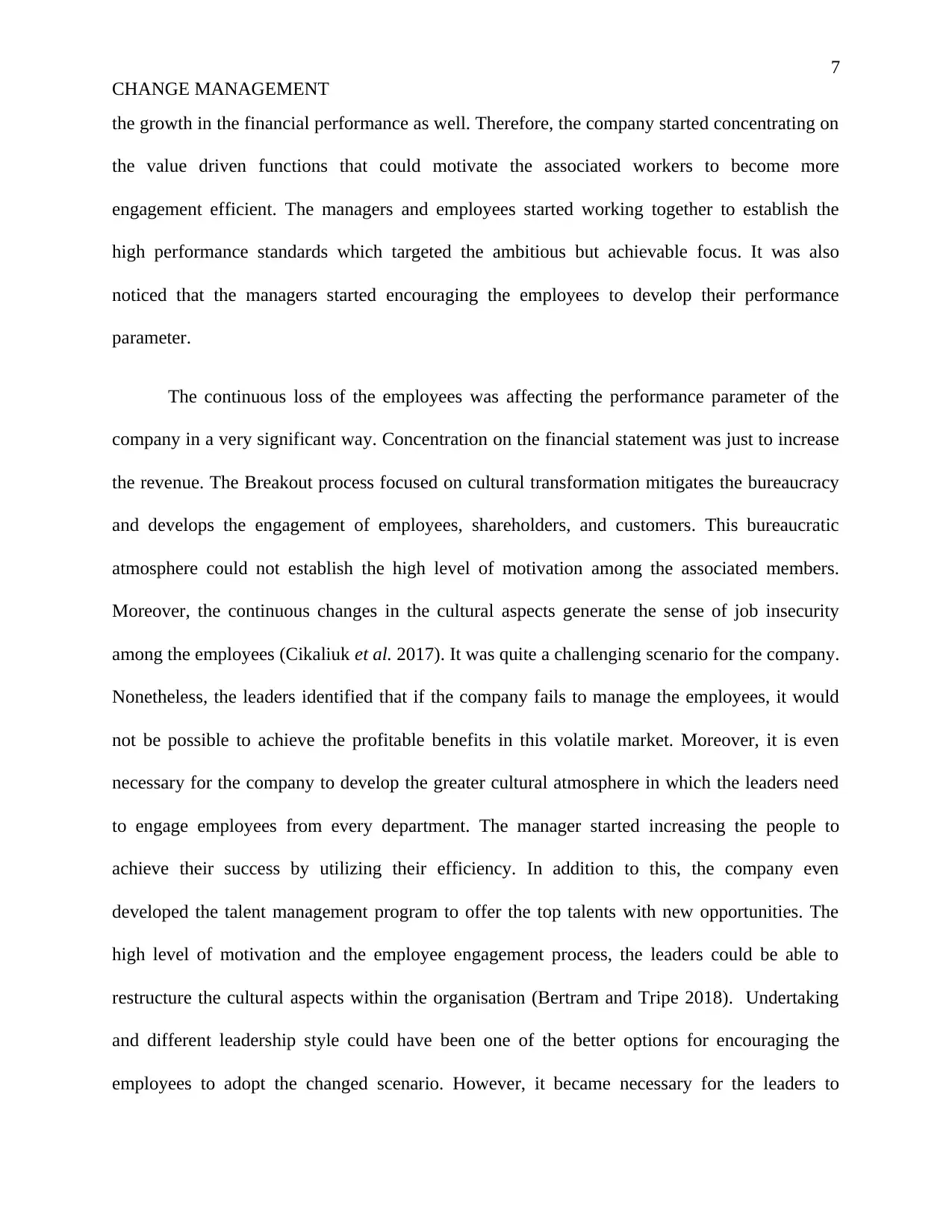
7
CHANGE MANAGEMENT
the growth in the financial performance as well. Therefore, the company started concentrating on
the value driven functions that could motivate the associated workers to become more
engagement efficient. The managers and employees started working together to establish the
high performance standards which targeted the ambitious but achievable focus. It was also
noticed that the managers started encouraging the employees to develop their performance
parameter.
The continuous loss of the employees was affecting the performance parameter of the
company in a very significant way. Concentration on the financial statement was just to increase
the revenue. The Breakout process focused on cultural transformation mitigates the bureaucracy
and develops the engagement of employees, shareholders, and customers. This bureaucratic
atmosphere could not establish the high level of motivation among the associated members.
Moreover, the continuous changes in the cultural aspects generate the sense of job insecurity
among the employees (Cikaliuk et al. 2017). It was quite a challenging scenario for the company.
Nonetheless, the leaders identified that if the company fails to manage the employees, it would
not be possible to achieve the profitable benefits in this volatile market. Moreover, it is even
necessary for the company to develop the greater cultural atmosphere in which the leaders need
to engage employees from every department. The manager started increasing the people to
achieve their success by utilizing their efficiency. In addition to this, the company even
developed the talent management program to offer the top talents with new opportunities. The
high level of motivation and the employee engagement process, the leaders could be able to
restructure the cultural aspects within the organisation (Bertram and Tripe 2018). Undertaking
and different leadership style could have been one of the better options for encouraging the
employees to adopt the changed scenario. However, it became necessary for the leaders to
CHANGE MANAGEMENT
the growth in the financial performance as well. Therefore, the company started concentrating on
the value driven functions that could motivate the associated workers to become more
engagement efficient. The managers and employees started working together to establish the
high performance standards which targeted the ambitious but achievable focus. It was also
noticed that the managers started encouraging the employees to develop their performance
parameter.
The continuous loss of the employees was affecting the performance parameter of the
company in a very significant way. Concentration on the financial statement was just to increase
the revenue. The Breakout process focused on cultural transformation mitigates the bureaucracy
and develops the engagement of employees, shareholders, and customers. This bureaucratic
atmosphere could not establish the high level of motivation among the associated members.
Moreover, the continuous changes in the cultural aspects generate the sense of job insecurity
among the employees (Cikaliuk et al. 2017). It was quite a challenging scenario for the company.
Nonetheless, the leaders identified that if the company fails to manage the employees, it would
not be possible to achieve the profitable benefits in this volatile market. Moreover, it is even
necessary for the company to develop the greater cultural atmosphere in which the leaders need
to engage employees from every department. The manager started increasing the people to
achieve their success by utilizing their efficiency. In addition to this, the company even
developed the talent management program to offer the top talents with new opportunities. The
high level of motivation and the employee engagement process, the leaders could be able to
restructure the cultural aspects within the organisation (Bertram and Tripe 2018). Undertaking
and different leadership style could have been one of the better options for encouraging the
employees to adopt the changed scenario. However, it became necessary for the leaders to
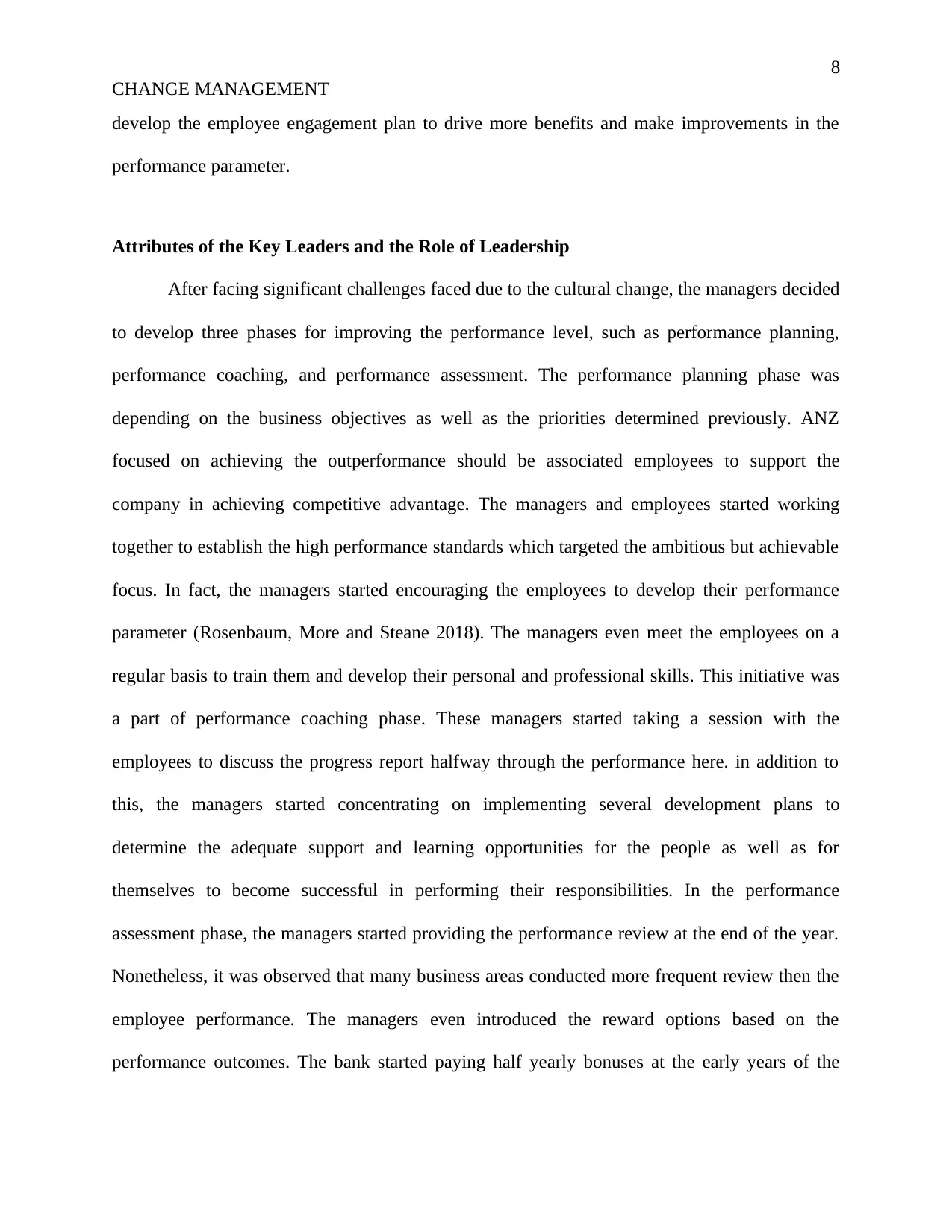
8
CHANGE MANAGEMENT
develop the employee engagement plan to drive more benefits and make improvements in the
performance parameter.
Attributes of the Key Leaders and the Role of Leadership
After facing significant challenges faced due to the cultural change, the managers decided
to develop three phases for improving the performance level, such as performance planning,
performance coaching, and performance assessment. The performance planning phase was
depending on the business objectives as well as the priorities determined previously. ANZ
focused on achieving the outperformance should be associated employees to support the
company in achieving competitive advantage. The managers and employees started working
together to establish the high performance standards which targeted the ambitious but achievable
focus. In fact, the managers started encouraging the employees to develop their performance
parameter (Rosenbaum, More and Steane 2018). The managers even meet the employees on a
regular basis to train them and develop their personal and professional skills. This initiative was
a part of performance coaching phase. These managers started taking a session with the
employees to discuss the progress report halfway through the performance here. in addition to
this, the managers started concentrating on implementing several development plans to
determine the adequate support and learning opportunities for the people as well as for
themselves to become successful in performing their responsibilities. In the performance
assessment phase, the managers started providing the performance review at the end of the year.
Nonetheless, it was observed that many business areas conducted more frequent review then the
employee performance. The managers even introduced the reward options based on the
performance outcomes. The bank started paying half yearly bonuses at the early years of the
CHANGE MANAGEMENT
develop the employee engagement plan to drive more benefits and make improvements in the
performance parameter.
Attributes of the Key Leaders and the Role of Leadership
After facing significant challenges faced due to the cultural change, the managers decided
to develop three phases for improving the performance level, such as performance planning,
performance coaching, and performance assessment. The performance planning phase was
depending on the business objectives as well as the priorities determined previously. ANZ
focused on achieving the outperformance should be associated employees to support the
company in achieving competitive advantage. The managers and employees started working
together to establish the high performance standards which targeted the ambitious but achievable
focus. In fact, the managers started encouraging the employees to develop their performance
parameter (Rosenbaum, More and Steane 2018). The managers even meet the employees on a
regular basis to train them and develop their personal and professional skills. This initiative was
a part of performance coaching phase. These managers started taking a session with the
employees to discuss the progress report halfway through the performance here. in addition to
this, the managers started concentrating on implementing several development plans to
determine the adequate support and learning opportunities for the people as well as for
themselves to become successful in performing their responsibilities. In the performance
assessment phase, the managers started providing the performance review at the end of the year.
Nonetheless, it was observed that many business areas conducted more frequent review then the
employee performance. The managers even introduced the reward options based on the
performance outcomes. The bank started paying half yearly bonuses at the early years of the
⊘ This is a preview!⊘
Do you want full access?
Subscribe today to unlock all pages.

Trusted by 1+ million students worldwide
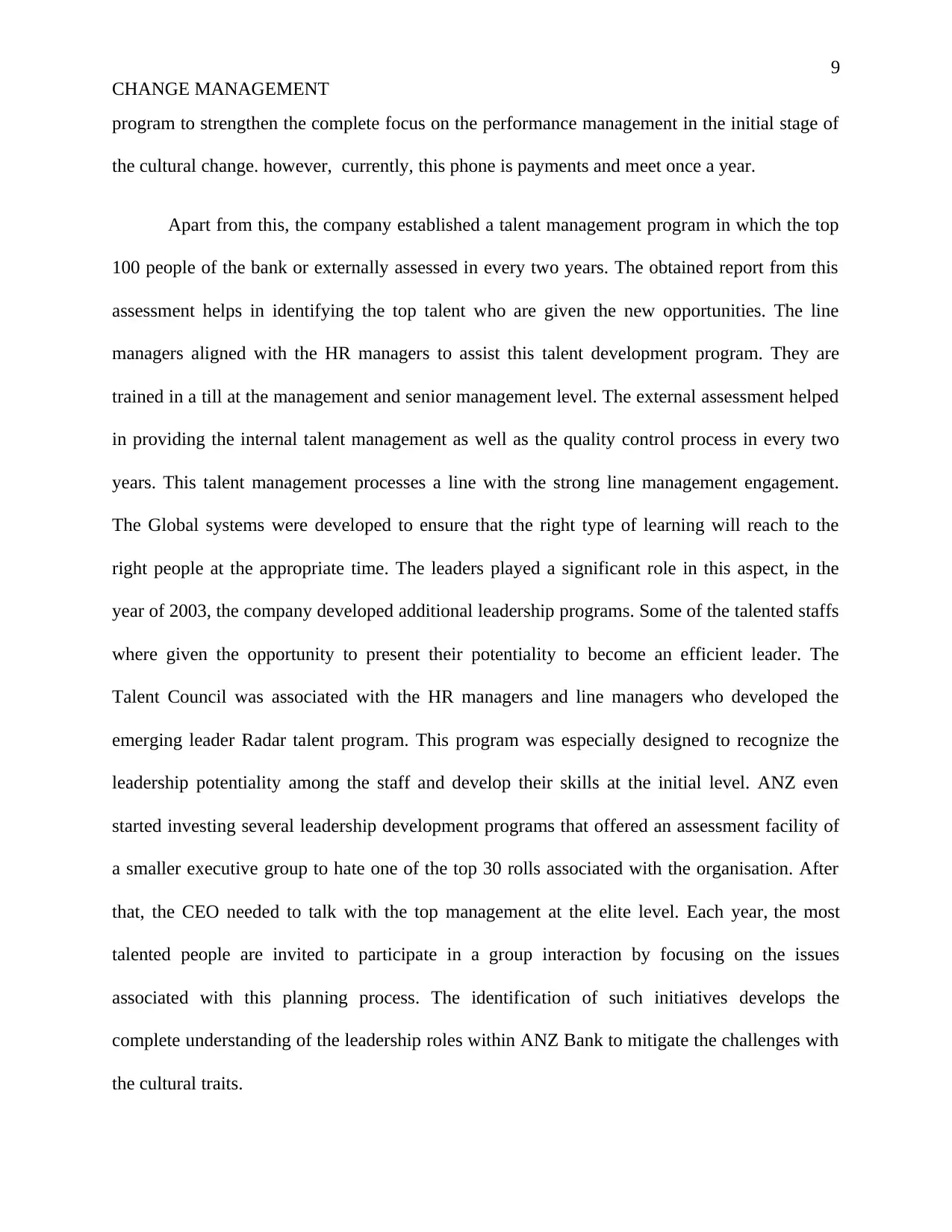
9
CHANGE MANAGEMENT
program to strengthen the complete focus on the performance management in the initial stage of
the cultural change. however, currently, this phone is payments and meet once a year.
Apart from this, the company established a talent management program in which the top
100 people of the bank or externally assessed in every two years. The obtained report from this
assessment helps in identifying the top talent who are given the new opportunities. The line
managers aligned with the HR managers to assist this talent development program. They are
trained in a till at the management and senior management level. The external assessment helped
in providing the internal talent management as well as the quality control process in every two
years. This talent management processes a line with the strong line management engagement.
The Global systems were developed to ensure that the right type of learning will reach to the
right people at the appropriate time. The leaders played a significant role in this aspect, in the
year of 2003, the company developed additional leadership programs. Some of the talented staffs
where given the opportunity to present their potentiality to become an efficient leader. The
Talent Council was associated with the HR managers and line managers who developed the
emerging leader Radar talent program. This program was especially designed to recognize the
leadership potentiality among the staff and develop their skills at the initial level. ANZ even
started investing several leadership development programs that offered an assessment facility of
a smaller executive group to hate one of the top 30 rolls associated with the organisation. After
that, the CEO needed to talk with the top management at the elite level. Each year, the most
talented people are invited to participate in a group interaction by focusing on the issues
associated with this planning process. The identification of such initiatives develops the
complete understanding of the leadership roles within ANZ Bank to mitigate the challenges with
the cultural traits.
CHANGE MANAGEMENT
program to strengthen the complete focus on the performance management in the initial stage of
the cultural change. however, currently, this phone is payments and meet once a year.
Apart from this, the company established a talent management program in which the top
100 people of the bank or externally assessed in every two years. The obtained report from this
assessment helps in identifying the top talent who are given the new opportunities. The line
managers aligned with the HR managers to assist this talent development program. They are
trained in a till at the management and senior management level. The external assessment helped
in providing the internal talent management as well as the quality control process in every two
years. This talent management processes a line with the strong line management engagement.
The Global systems were developed to ensure that the right type of learning will reach to the
right people at the appropriate time. The leaders played a significant role in this aspect, in the
year of 2003, the company developed additional leadership programs. Some of the talented staffs
where given the opportunity to present their potentiality to become an efficient leader. The
Talent Council was associated with the HR managers and line managers who developed the
emerging leader Radar talent program. This program was especially designed to recognize the
leadership potentiality among the staff and develop their skills at the initial level. ANZ even
started investing several leadership development programs that offered an assessment facility of
a smaller executive group to hate one of the top 30 rolls associated with the organisation. After
that, the CEO needed to talk with the top management at the elite level. Each year, the most
talented people are invited to participate in a group interaction by focusing on the issues
associated with this planning process. The identification of such initiatives develops the
complete understanding of the leadership roles within ANZ Bank to mitigate the challenges with
the cultural traits.
Paraphrase This Document
Need a fresh take? Get an instant paraphrase of this document with our AI Paraphraser
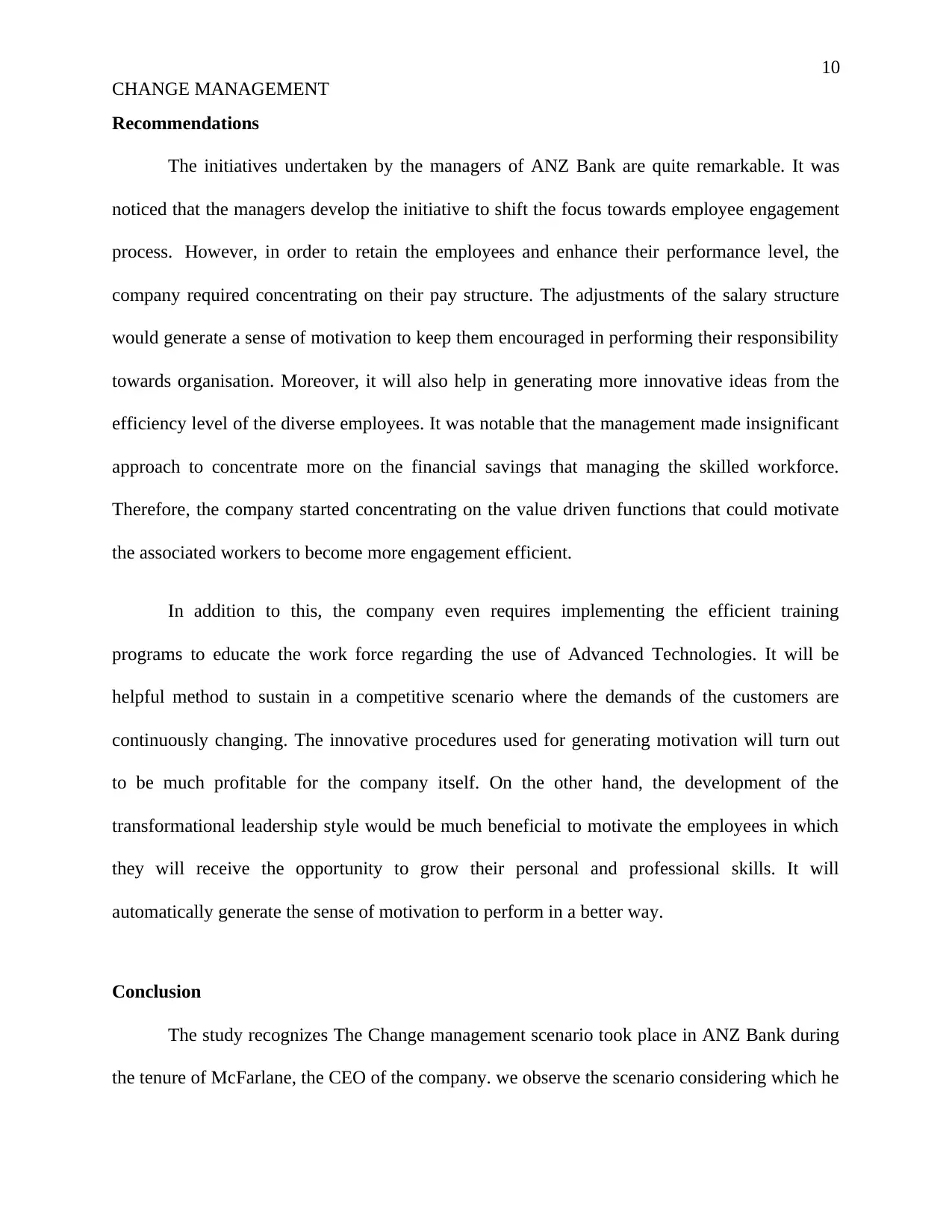
10
CHANGE MANAGEMENT
Recommendations
The initiatives undertaken by the managers of ANZ Bank are quite remarkable. It was
noticed that the managers develop the initiative to shift the focus towards employee engagement
process. However, in order to retain the employees and enhance their performance level, the
company required concentrating on their pay structure. The adjustments of the salary structure
would generate a sense of motivation to keep them encouraged in performing their responsibility
towards organisation. Moreover, it will also help in generating more innovative ideas from the
efficiency level of the diverse employees. It was notable that the management made insignificant
approach to concentrate more on the financial savings that managing the skilled workforce.
Therefore, the company started concentrating on the value driven functions that could motivate
the associated workers to become more engagement efficient.
In addition to this, the company even requires implementing the efficient training
programs to educate the work force regarding the use of Advanced Technologies. It will be
helpful method to sustain in a competitive scenario where the demands of the customers are
continuously changing. The innovative procedures used for generating motivation will turn out
to be much profitable for the company itself. On the other hand, the development of the
transformational leadership style would be much beneficial to motivate the employees in which
they will receive the opportunity to grow their personal and professional skills. It will
automatically generate the sense of motivation to perform in a better way.
Conclusion
The study recognizes The Change management scenario took place in ANZ Bank during
the tenure of McFarlane, the CEO of the company. we observe the scenario considering which he
CHANGE MANAGEMENT
Recommendations
The initiatives undertaken by the managers of ANZ Bank are quite remarkable. It was
noticed that the managers develop the initiative to shift the focus towards employee engagement
process. However, in order to retain the employees and enhance their performance level, the
company required concentrating on their pay structure. The adjustments of the salary structure
would generate a sense of motivation to keep them encouraged in performing their responsibility
towards organisation. Moreover, it will also help in generating more innovative ideas from the
efficiency level of the diverse employees. It was notable that the management made insignificant
approach to concentrate more on the financial savings that managing the skilled workforce.
Therefore, the company started concentrating on the value driven functions that could motivate
the associated workers to become more engagement efficient.
In addition to this, the company even requires implementing the efficient training
programs to educate the work force regarding the use of Advanced Technologies. It will be
helpful method to sustain in a competitive scenario where the demands of the customers are
continuously changing. The innovative procedures used for generating motivation will turn out
to be much profitable for the company itself. On the other hand, the development of the
transformational leadership style would be much beneficial to motivate the employees in which
they will receive the opportunity to grow their personal and professional skills. It will
automatically generate the sense of motivation to perform in a better way.
Conclusion
The study recognizes The Change management scenario took place in ANZ Bank during
the tenure of McFarlane, the CEO of the company. we observe the scenario considering which he
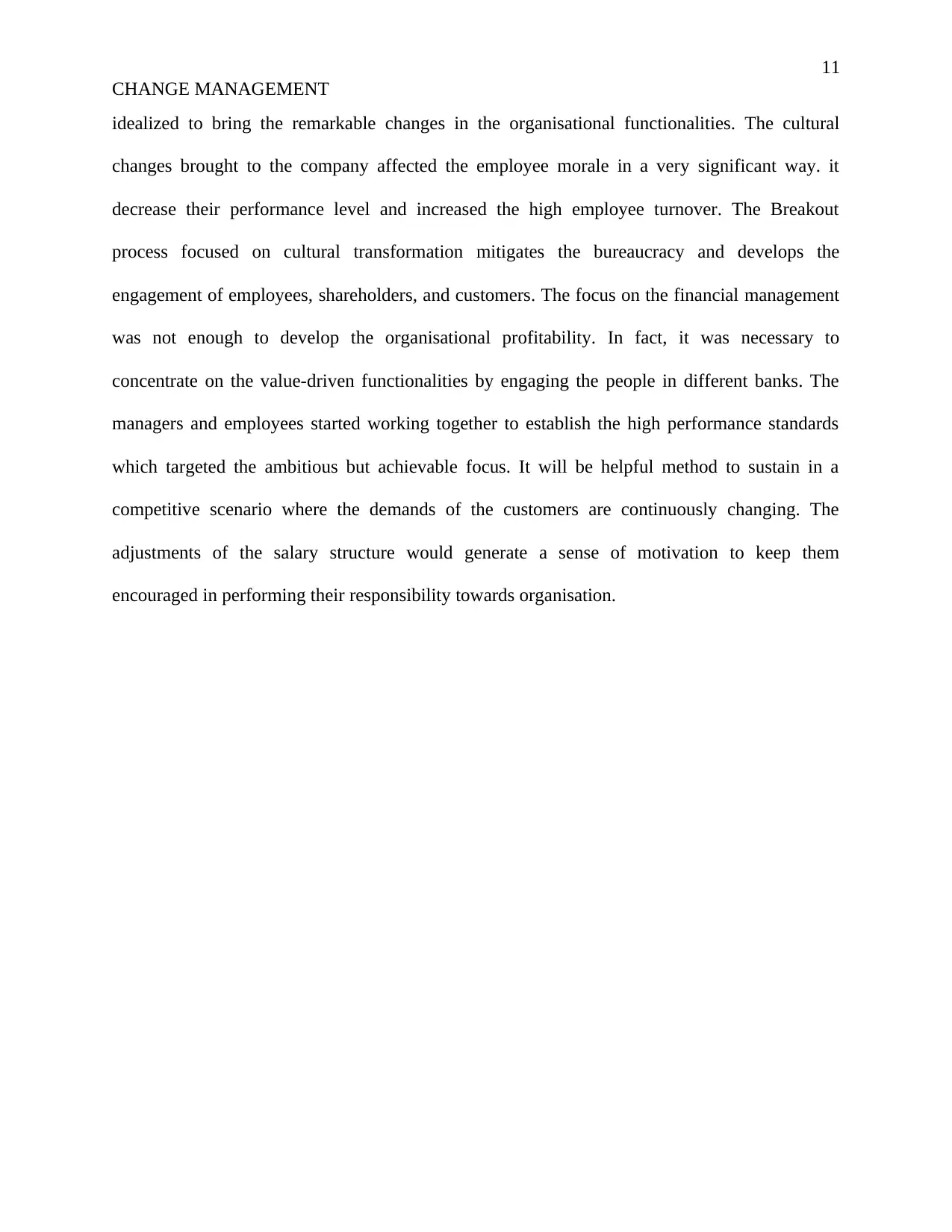
11
CHANGE MANAGEMENT
idealized to bring the remarkable changes in the organisational functionalities. The cultural
changes brought to the company affected the employee morale in a very significant way. it
decrease their performance level and increased the high employee turnover. The Breakout
process focused on cultural transformation mitigates the bureaucracy and develops the
engagement of employees, shareholders, and customers. The focus on the financial management
was not enough to develop the organisational profitability. In fact, it was necessary to
concentrate on the value-driven functionalities by engaging the people in different banks. The
managers and employees started working together to establish the high performance standards
which targeted the ambitious but achievable focus. It will be helpful method to sustain in a
competitive scenario where the demands of the customers are continuously changing. The
adjustments of the salary structure would generate a sense of motivation to keep them
encouraged in performing their responsibility towards organisation.
CHANGE MANAGEMENT
idealized to bring the remarkable changes in the organisational functionalities. The cultural
changes brought to the company affected the employee morale in a very significant way. it
decrease their performance level and increased the high employee turnover. The Breakout
process focused on cultural transformation mitigates the bureaucracy and develops the
engagement of employees, shareholders, and customers. The focus on the financial management
was not enough to develop the organisational profitability. In fact, it was necessary to
concentrate on the value-driven functionalities by engaging the people in different banks. The
managers and employees started working together to establish the high performance standards
which targeted the ambitious but achievable focus. It will be helpful method to sustain in a
competitive scenario where the demands of the customers are continuously changing. The
adjustments of the salary structure would generate a sense of motivation to keep them
encouraged in performing their responsibility towards organisation.
⊘ This is a preview!⊘
Do you want full access?
Subscribe today to unlock all pages.

Trusted by 1+ million students worldwide
1 out of 14
Related Documents
Your All-in-One AI-Powered Toolkit for Academic Success.
+13062052269
info@desklib.com
Available 24*7 on WhatsApp / Email
![[object Object]](/_next/static/media/star-bottom.7253800d.svg)
Unlock your academic potential
Copyright © 2020–2025 A2Z Services. All Rights Reserved. Developed and managed by ZUCOL.





